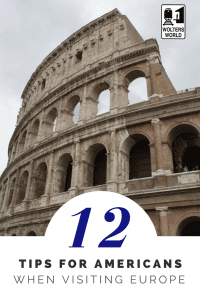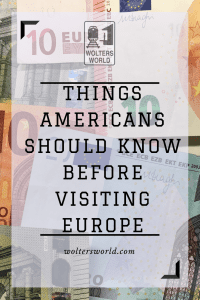What Tourists Should Know Before Visiting Europe
There are some big differences between Europe and the U.S. and I’ve got a few to share with you. Of course, these are in a very general sense as not all European countries are the same.

Language in Europe
In Europe, most young people speak English as they are learning it in school. Also, in the tourism industry, most people will speak English. Technically, only 51% of Europeans speak English, so it’s always helpful to learn a few words of the native language. We have videos for these – 10 Words You Should Know in German, 4 French Phrases Every Tourist Should Know, Top 10 Spanish Words Travelers Should Know. Of course, there are some English speaking countries in Europe as well.
Currencies in Europe
Most European countries use the Euro, which comes in several bills (500, 200, 100, 50, 10, 5) and the coins here are actually valuable. The 2 Euro coin is worth more than $2, so keep track of them.
For the best Euro to Dollar rate, use your debit card at an ATM machine. Take out your money in Euros, rather than dollars, as your bank will likely provide a better rate than the ATM bank. If you prefer to exchange cash, then go to a bank, where you have less chance of getting ripped off or receiving counterfeit bills.
Countries that use the Euro (as of 2018) include:
- Austria
- Belgium
- Cyprus
- Estonia
- Finland
- France
- Germany
- Greece
- Ireland
- Italy
- Latvia
- Lithuania
- Luxembourg
- Malta
- Monaco/Monte Carlo
- The Netherlands
- Portugal
- San Marino
- Slovakia
- Slovenia
- Spain
- Vatican City
Some other countries don’t use the Euro and have their own currency. Some examples.
- United Kingdom: British Pound Sterling
- Sweden: Krona
- Norway: Krone
- Czech Republic: Koruna
- Denmark: Krone
- Hungary: Florint
- Switzerland: Francs
- Serbia: Dinar
- Croatia: Kuna
- Russia: Ruble
Tip: Cash is king in the Europe! Make sure you always have some cash on hand in case the establishment doesn’t take credit cards, or only takes a credit card with a chip or PIN.
Tipping in Europe
Tipping is very different across Europe and will vary by country. In Austria, it’s 10%. Germany, tip 5-10% for good service. In England, it’s about 10%. Other places, like Portugal, you can leave a few coins, or you might not leave any tip. Check out our videos “Tipping Around the World” for more specifics. Just don’t assume it will be the same across Europe. Some places charge a sit-down fee vs take-away, or a cover charge or “bread charge.” If such a service charge is added, you don’t need to add a tip.
Costs of Europe
The biggest expense will be your flight to Europe. Hotels are generally cheaper in Europe for a comparable hotel level. Eating in Europe can be more or less expensive. Northern Europe is more expensive than Southern Europe. Western Europe is more expensive than Eastern Europe. Travel costs in Europe are very regional.
Everyday Differences Between Europe and the USA
- Plugs in Europe are different than the U.S. In most of Europe, you’ll see two round pegs for the holes, while the U.K and Italy have different systems. The best option is a multiple country adapter that covers all the place you’ll be visiting. You will need an adapter for charging any electronics. Your laptop or phone will have a converter built in, so you just need the adapter part.
- When it comes to toilets in Europe, sometimes you will have to pay to use one, especially in train stations. Other bathrooms may have an attendant looking for a tip. Squat toilets exist, but aren’t very common in Europe.
- Drinking water in the European Union is safe to drink. Most people in Europe buy bottled water over tap water because it will taste better, but it’s generally safe to drink or at least brush your teeth. (St. Petersburg is an exception, do not even brush your teeth with tap water!)
- WiFi is not as widespread in Europe as it is in the U.S. Your hotel may or may not have it, and if they do, it may be considerable slower than what you are used to.
Hotels in Europe
Hotels rooms in Europe are much smaller than hotel rooms in the United States. A double room will actually be two single beds pushed together, so beware the crack in the middle of your double bed. If you are traveling as a family with children, you will need to get multiple hotel rooms.

Restaurants in Europe
You will find more sit-down restaurants in Europe, and fewer fast food joints than you are used to seeing in the United States. There are fast food chains specific to Europe, though, and it’s fun to check them out, such as Doner Kabab. Also, unlike the U.S., servers in Europe are usually paid a full wage and don’t rely on tips for their income. This also means your service is less attentive as they’re not trying to get big tips. You may have to flag down your server, and you won’t get free refills on your soda. In general, service is fine, but less attentive than in the U.S.
Safety in Europe
Generally, Europe is very safe, and feels much safer than many cities in the U.S. There are a few spots known for pickpockets in Europe, usually on public transport and at major tourist sites. It’s no different than any large city in the U.S., just be smart and aware of your surroundings.
Public Transport in Europe
Unlike the United States, public transport is fantastic in Europe. In a small country like Belgium, you can get all over the country on trains that are frequent, fast and affordable. Even when traveling between countries, there are many train and bus options, and they are safe, unlike some of the bus routes in the U.S. It is very easy to travel Europe by train.
More Resources
We have lots of videos specific to countries in Europe that will help you plan your trip. Here’s a few to get you started:
5 Things You Will Love & Hate About Belgium
5 Things You Will Love & Hate About Europe
5 Things You Will Love & Hate About America
